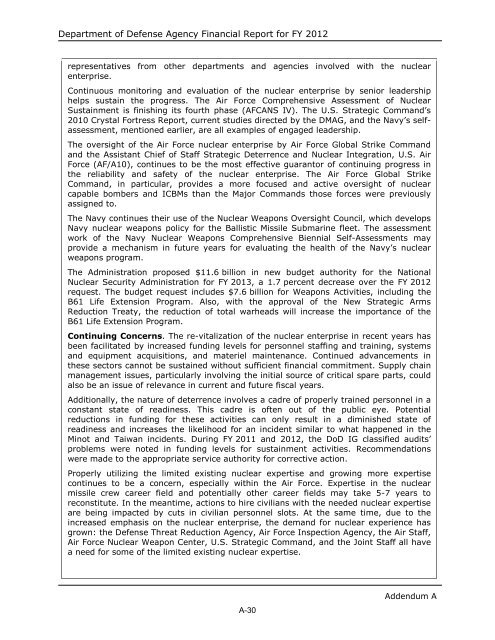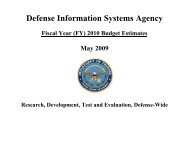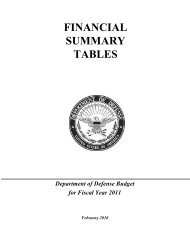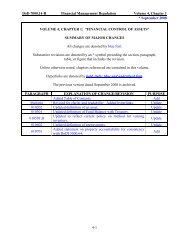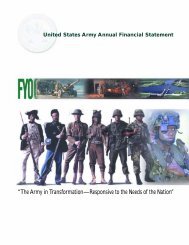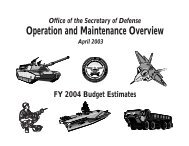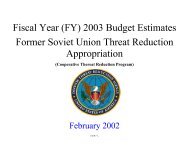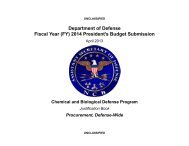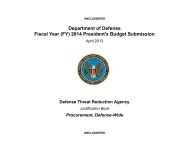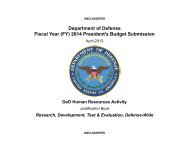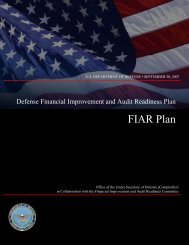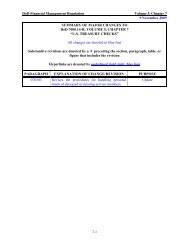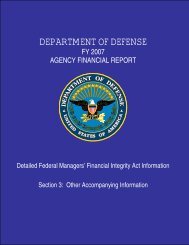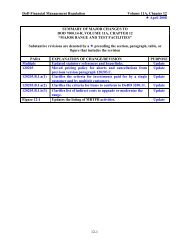department of defense agency financial report fiscal year 2012
department of defense agency financial report fiscal year 2012
department of defense agency financial report fiscal year 2012
Create successful ePaper yourself
Turn your PDF publications into a flip-book with our unique Google optimized e-Paper software.
Department <strong>of</strong> Defense Agency Financial Report for FY <strong>2012</strong><br />
representatives from other <strong>department</strong>s and agencies involved with the nuclear<br />
enterprise.<br />
Continuous monitoring and evaluation <strong>of</strong> the nuclear enterprise by senior leadership<br />
helps sustain the progress. The Air Force Comprehensive Assessment <strong>of</strong> Nuclear<br />
Sustainment is finishing its fourth phase (AFCANS IV). The U.S. Strategic Command’s<br />
2010 Crystal Fortress Report, current studies directed by the DMAG, and the Navy’s selfassessment,<br />
mentioned earlier, are all examples <strong>of</strong> engaged leadership.<br />
The oversight <strong>of</strong> the Air Force nuclear enterprise by Air Force Global Strike Command<br />
and the Assistant Chief <strong>of</strong> Staff Strategic Deterrence and Nuclear Integration, U.S. Air<br />
Force (AF/A10), continues to be the most effective guarantor <strong>of</strong> continuing progress in<br />
the reliability and safety <strong>of</strong> the nuclear enterprise. The Air Force Global Strike<br />
Command, in particular, provides a more focused and active oversight <strong>of</strong> nuclear<br />
capable bombers and ICBMs than the Major Commands those forces were previously<br />
assigned to.<br />
The Navy continues their use <strong>of</strong> the Nuclear Weapons Oversight Council, which develops<br />
Navy nuclear weapons policy for the Ballistic Missile Submarine fleet. The assessment<br />
work <strong>of</strong> the Navy Nuclear Weapons Comprehensive Biennial Self-Assessments may<br />
provide a mechanism in future <strong>year</strong>s for evaluating the health <strong>of</strong> the Navy’s nuclear<br />
weapons program.<br />
The Administration proposed $11.6 billion in new budget authority for the National<br />
Nuclear Security Administration for FY 2013, a 1.7 percent decrease over the FY <strong>2012</strong><br />
request. The budget request includes $7.6 billion for Weapons Activities, including the<br />
B61 Life Extension Program. Also, with the approval <strong>of</strong> the New Strategic Arms<br />
Reduction Treaty, the reduction <strong>of</strong> total warheads will increase the importance <strong>of</strong> the<br />
B61 Life Extension Program.<br />
Continuing Concerns. The re-vitalization <strong>of</strong> the nuclear enterprise in recent <strong>year</strong>s has<br />
been facilitated by increased funding levels for personnel staffing and training, systems<br />
and equipment acquisitions, and materiel maintenance. Continued advancements in<br />
these sectors cannot be sustained without sufficient <strong>financial</strong> commitment. Supply chain<br />
management issues, particularly involving the initial source <strong>of</strong> critical spare parts, could<br />
also be an issue <strong>of</strong> relevance in current and future <strong>fiscal</strong> <strong>year</strong>s.<br />
Additionally, the nature <strong>of</strong> deterrence involves a cadre <strong>of</strong> properly trained personnel in a<br />
constant state <strong>of</strong> readiness. This cadre is <strong>of</strong>ten out <strong>of</strong> the public eye. Potential<br />
reductions in funding for these activities can only result in a diminished state <strong>of</strong><br />
readiness and increases the likelihood for an incident similar to what happened in the<br />
Minot and Taiwan incidents. During FY 2011 and <strong>2012</strong>, the DoD IG classified audits’<br />
problems were noted in funding levels for sustainment activities. Recommendations<br />
were made to the appropriate service authority for corrective action.<br />
Properly utilizing the limited existing nuclear expertise and growing more expertise<br />
continues to be a concern, especially within the Air Force. Expertise in the nuclear<br />
missile crew career field and potentially other career fields may take 5-7 <strong>year</strong>s to<br />
reconstitute. In the meantime, actions to hire civilians with the needed nuclear expertise<br />
are being impacted by cuts in civilian personnel slots. At the same time, due to the<br />
increased emphasis on the nuclear enterprise, the demand for nuclear experience has<br />
grown: the Defense Threat Reduction Agency, Air Force Inspection Agency, the Air Staff,<br />
Air Force Nuclear Weapon Center, U.S. Strategic Command, and the Joint Staff all have<br />
a need for some <strong>of</strong> the limited existing nuclear expertise.<br />
A-30<br />
Addendum A


